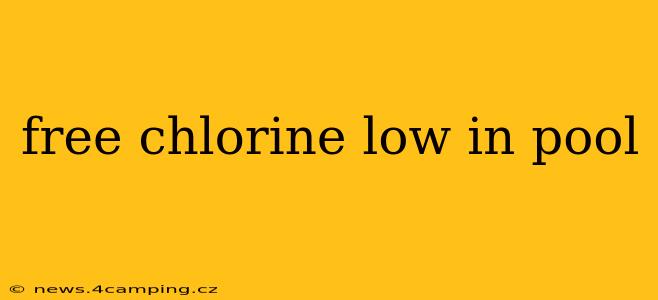Maintaining the proper chlorine levels in your swimming pool is crucial for ensuring a safe and enjoyable swimming experience. Low free chlorine levels can lead to bacterial growth, cloudy water, and unpleasant odors. If you've discovered your free chlorine is low, don't panic! This guide will walk you through troubleshooting the problem and getting your pool back to sparkling clean.
Why is My Free Chlorine Low?
Several factors can contribute to low free chlorine levels. Understanding these causes is the first step to effectively addressing the issue.
-
High bather load: A large number of swimmers using the pool depletes chlorine more rapidly. Body oils, lotions, and other contaminants introduced by swimmers consume chlorine.
-
Excessive sunlight: UV rays from the sun break down chlorine, reducing its effectiveness. This is particularly true during peak sunlight hours.
-
Contaminants: Leaves, pollen, dirt, and other organic matter consume chlorine as it works to disinfect the water. Regular pool cleaning is essential.
-
Improper chemical balance: Imbalances in pH, alkalinity, and calcium hardness can affect chlorine's effectiveness and its ability to remain stable in the water.
-
Inefficient filtration system: A malfunctioning pump, clogged filter, or inadequate filter size can't effectively remove contaminants, leading to increased chlorine consumption.
How Often Should I Test My Pool Water?
Regular testing is vital for maintaining optimal water chemistry. Aim to test your pool water at least twice a week, and more frequently during periods of high use or inclement weather. Consistent monitoring allows you to address any issues promptly before they escalate.
What Happens if My Pool's Free Chlorine is Too Low?
Low free chlorine levels pose significant risks:
-
Algae growth: Insufficient chlorine allows algae to flourish, turning your pool green and slimy.
-
Bacterial growth: Bacteria thrive in environments lacking sufficient chlorine, posing health risks to swimmers.
-
Cloudy water: Insufficient chlorine leaves contaminants suspended in the water, leading to cloudiness.
-
Unpleasant odors: The build-up of organic matter and bacteria without adequate chlorine disinfection can lead to foul-smelling water.
How Can I Raise My Pool's Free Chlorine Levels?
Once you've identified the cause of low chlorine, you can take steps to restore balance:
-
Shock the pool: Adding a chlorine shock treatment significantly increases the chlorine level, quickly oxidizing contaminants and killing bacteria. Follow the product instructions carefully.
-
Add chlorine tablets or granules: These are commonly used to maintain consistent chlorine levels. Follow package instructions for appropriate dosage based on your pool's size.
-
Balance the water chemistry: Adjust pH, alkalinity, and calcium hardness to optimal levels. An imbalance can hinder chlorine effectiveness. Use test strips or a test kit to determine the precise levels and adjust accordingly.
-
Clean the pool: Regularly remove debris such as leaves, insects, and other contaminants from the pool and surrounding area. Backwash or clean your filter as needed. Ensure your skimmer basket is emptied frequently.
What Should I Do If My Pool Remains Cloudy Even After Adding Chlorine?
If your pool remains cloudy after adding chlorine, it indicates that other issues need attention:
-
Filter cleaning: A clogged filter reduces the filtration efficiency, allowing suspended particles to remain in the water. Clean or replace the filter.
-
Water chemistry imbalance: Even after adding chlorine, if other chemical parameters like pH and alkalinity are out of balance, the chlorine won't function effectively. Retest and adjust as necessary.
-
Flocculant addition: A flocculant helps clump together fine particles, making them easier for the filter to remove, resulting in clearer water. Follow product instructions carefully.
How Often Should I Shock My Pool?
The frequency of shocking your pool depends on several factors, including bather load, weather conditions, and the type of sanitizer used. As a general guideline, shocking your pool once a week to once a month is typically sufficient for maintaining a healthy chlorine level. More frequent shocking may be necessary during periods of heavy use or extreme weather conditions. Always follow the manufacturer's instructions for your specific pool shock product.
By understanding the causes of low free chlorine and implementing the appropriate solutions, you can ensure your pool remains clean, safe, and enjoyable for everyone. Remember, regular testing and maintenance are key to preventing problems before they arise.
